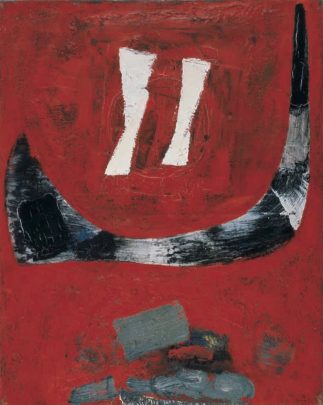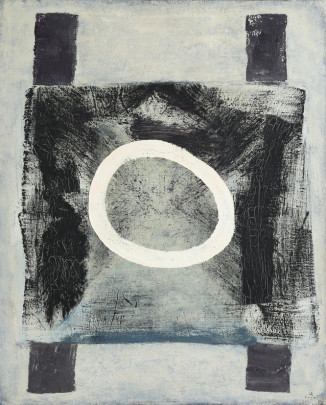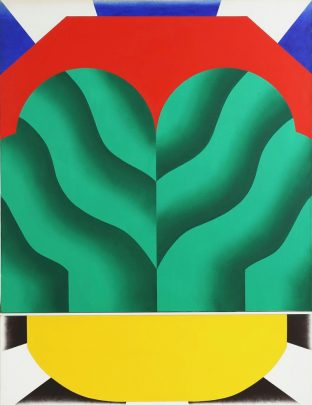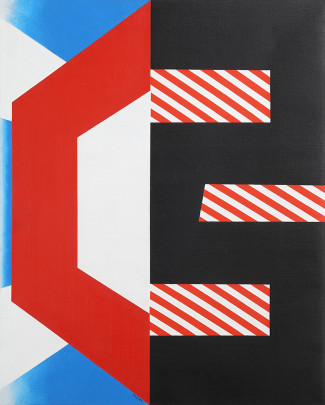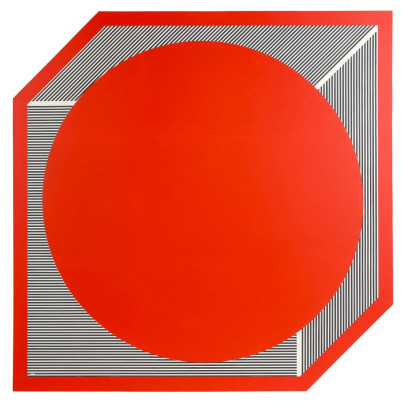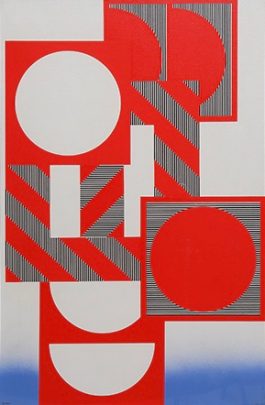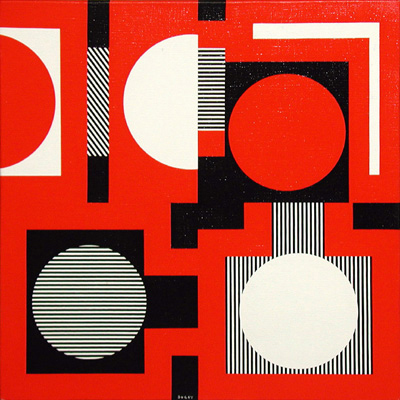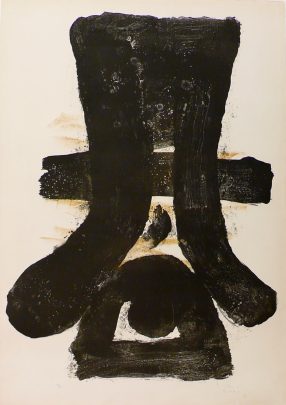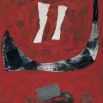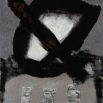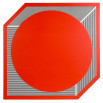菅井 汲 SUGAI Kumi 1919–1996
- 鬼 1957年 油彩・キャンバス 92x73cm 姫路市立美術館蔵
Oni (Ogre) 1957 oil on canvas 92x73cm Collection of Himeji City Museum of Art - 風 1959年 油彩・キャンバス 100x80.7cm 販売済み
Kaze (Wind) 1959 oil on canvas 100x80.7cm sold - 沖 1960年 油彩・キャンバス 162x130cm 島根県立美術館蔵
Oki (Offshore) 1960 oil on canvas 162x130cm Collection of Shimane Art Museum - 太陽の森のパーキング 1966年 油彩・キャンバス 169x130cm ポーラ美術振興財団蔵
Parking dans Forêt au Soleil 1966 oil on canvas 169x130cm collection of Pola Art Foundation - 緑の太陽と月 1967-68年 油彩・キャンバス 150x150cm
Soleil vert, Lune 1967-68 oil on canvas 150x150cm - SEPT SECONDES AVANT 油彩・キャンバス 1968年 80.0x65.0cm
SEPT SECONDES AVANT oil on canvas 1968 80.0x65.0cm - 大きな球(赤) アクリル・キャンバス 1971年 200x200cm 販売済み
Grande Balle Rouge acrylic on canvas 1971 200x200cm sold - Festival E 1971年 アクリル・キャンバス 86x56cm
Festival E 1971 acrylic on canvas 86x56cm - Festival A-P 1972年 油彩・キャンバス 40×40cm
Festival A-P 1972 oil on canvas 40×40cm - 赤 1958年 リトグラフ Ed.150 65x50cm(シートサイズ)
AKA 1958 lithograph Ed.150 65x50cm (paper size) - 大男 1961年 リトグラフ Ed.10 90x63cm(シートサイズ) 販売済み
Grand Homme 1961 lithograph Ed.10 90x63cm (paper size) sold - スガイ:最大の緊張 1962年 エッチング10点 Ed.50 各60x50cm(シートサイズ)
SUGAÏ : ou La Tension Maxima 1962 album of 10 etchings Ed.50 each 60x50cm (paper size)
神戸市に生まれる。本名貞三。音楽家や美術家が生家に頻繁に訪れる社交的、文化的な環境の中で育つ。33年、大阪美術学校入学。37年、阪急電鉄宣伝課に就職、ポスターデザインに従事。49年、阪急電鉄退社。教科書の挿絵や阪急電鉄からのポスターデザイン委嘱の仕事で生活する。52年6月、渡仏。54年、クラヴァン画廊と契約。日本の古代を意識した東洋的な主題をプリミティヴな抽象で表現した作品を発表した同画廊での初個展はパリの画壇に強いインパクトを与える。58年のクルーズヴォ画廊における個展では、今までにない大きな色面、大胆な筆触描かれた≪太鼓≫、≪姫≫などを発表、作風の転換を示す。63年、クルーズヴォ画廊での個展を契機に、菅井は「オートルート」のシリーズへと至る、明快さとスピード感が画面の中で膨張していく形態を繰り返し描くようになる。特に64年の≪朝のオートルート≫(東京国立近代美術館蔵)以降は、その作品を「静的な緊張感」から「動的な緊張感」のあるものとして表現していく。67年、ユーゴスラヴィアのヴァカンス先からパリへと向かう途中、ドイツ国境を越えた直後、ナショナル・ルートNo.4の路上で事故を起こす。夫人と共に一命はとりとめるが、その後8年間事故の後遺症は続いた。しかし事故後もより高性能な車を幾度も買い換え、スピードによって得られる緊張感を制作へと昇華させていく。71年、「フェスティバル」シリーズの制作を開始。またこの年、同じ形態と色彩をパターン化した無数の作品制作を考え、その延長として、ウィーンで5500枚のシルクスクリーンを制作。72年、小雑誌形式での作品集を多数廉価版としてフランスで出版。70年代後半の「ヴァリアシオン」シリーズでは、より厳密に基本単位を反復して画面を構成する。83年、日本における初の回顧展開催。この時期、斜線は45度、形態の寸法はその作品における倍率の基準に従うといったように、作品は自動的に構成され、よりパターン化されていった。87年から91年まで「S」シリーズを展開。「S」字を基本とした構図は、晩年の「カドミウム・レッド」シリーズや「S.サークルズ」シリーズへと続いていく。96年2月、帰国。同年5月、神戸にて死去。
<「あるコレクターがみた戦後日本美術」展(2001~2002年、群馬県立近代美術館および愛媛県美術館を巡回)図録より引用>
Kumi Sugaï was born on March 13, 1919, in Kobe, Japan. Sugaï first experimented with oil painting at age nine and became a student at the Osaka School of Fine Arts in 1933 when he was fourteen. He was part of the first generation of 20th-century Japanese artists to become acquainted with Western painting techniques, but he also explored both typography and Japanese calligraphy, important in his subsequent work. Sugaï left art school prematurely to work in commercial advertising for Hankyu electric rail company from 1937 to 1945. During the 1940s, Sugaï gradually became familiar with the work of European artists such as Max Ernst, Paul Klee, and Joan Miró, and late in that decade he discovered the work of Americans Alexander Calder and Jackson Pollock through art magazines.
He dedicated himself to painting and moved to Paris in 1952, enrolling at the Académie de la grand chaumière. He had his first solo show at Galerie Craven in 1954. Considered part of the École de Paris (School of Paris) and the Nouveau Réalisme (New Realism) movements, in 1962 he began to shift away from the abstraction in vogue on his arrival in Paris, moving from calligraphic, mainly monochromatic, organic motifs to more hard-edge geometric imagery. Sugaï collaborated with critic Jean-Clarence Lambert to illustrate two books of poetry in 1957, and began writing short-form essays before publishing a book, La quête sans fin (Endless quest), in 1970. His work of the 1960s and 1970s featured large capitals and reduced typographic forms. Often he would make a letter the sole subject of the picture, for example the well-known S series in which the letter became almost anthropomorphic due to Sugaï’s manipulation of color and placement.
Sugaï participated in the Pittsburgh International (now Carnegie International) five times between 1955 and 1970; Exposition universelle, Brussels (1958); and Documenta, Kassel, West Germany (1959, 1964). He received midcareer retrospectives at the Städtisches Museum, Leverkusen, West Germany (1960), and Kunstnernes Hus, Oslo (1967). His work also was included in Painting and Sculpture of the Decade (1964), Tate Gallery, London, and he participated in the São Paulo Biennial (the prize for Foreign Artist, 1965) and the French Pavilion, Exposition universelle, Montreal (1967). Following a major car accident in 1967, from which he recovered in Paris, he received and completed the commissions for a mural for the National Museum of Modern Art, Tokyo (1968–69), and a public mural in the sport center in Hannover, West Germany, for the 1972 Olympics. A major retrospective was held at the Seibu Museum of Art, Tokyo (1983), and traveled to Ohara Museum of Art, Kurashiki, Japan (1984). Sugaï died on May 14, 1996, in Kobe.
< from GUGGENHEIM - Collection Online >
